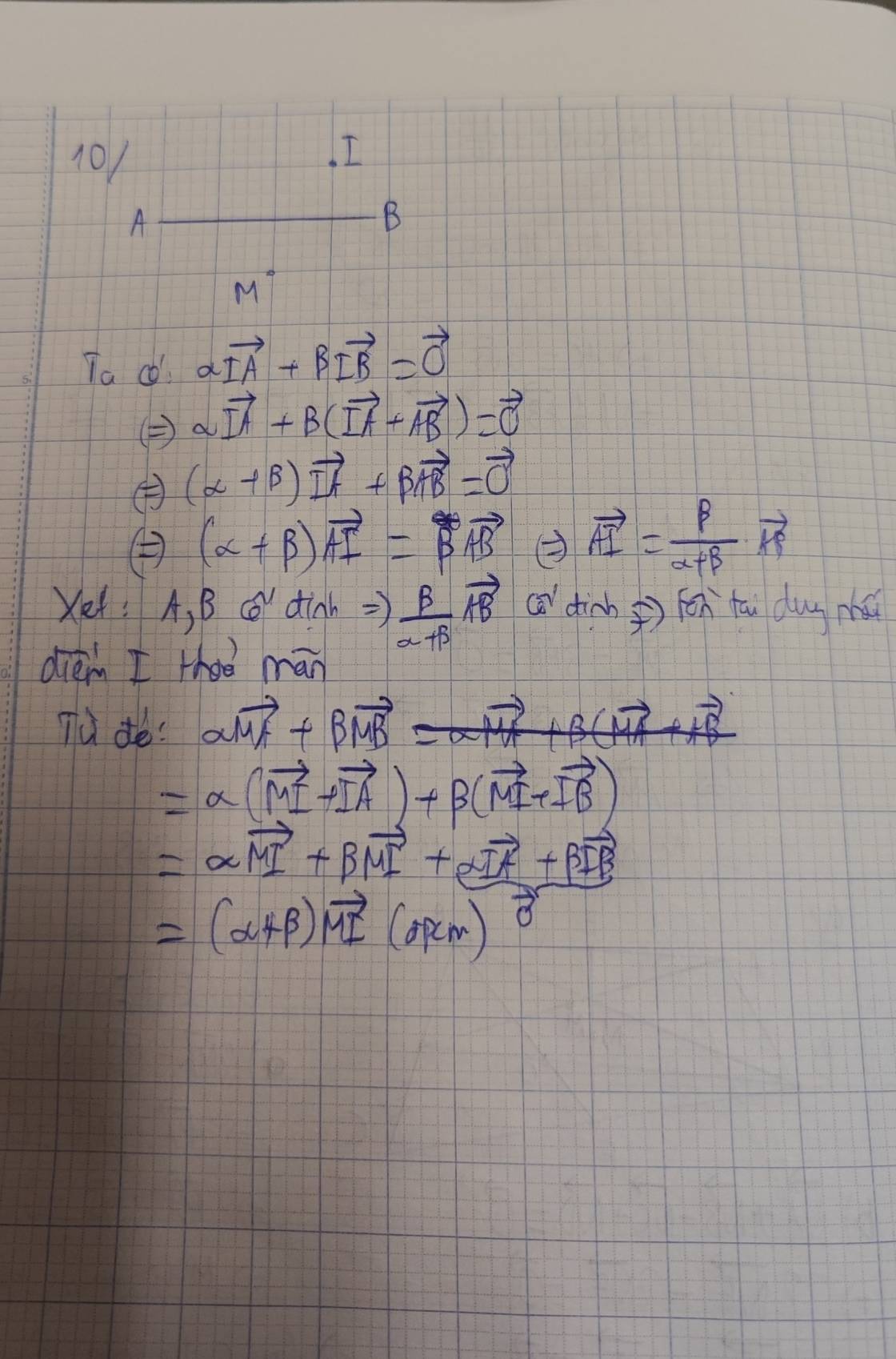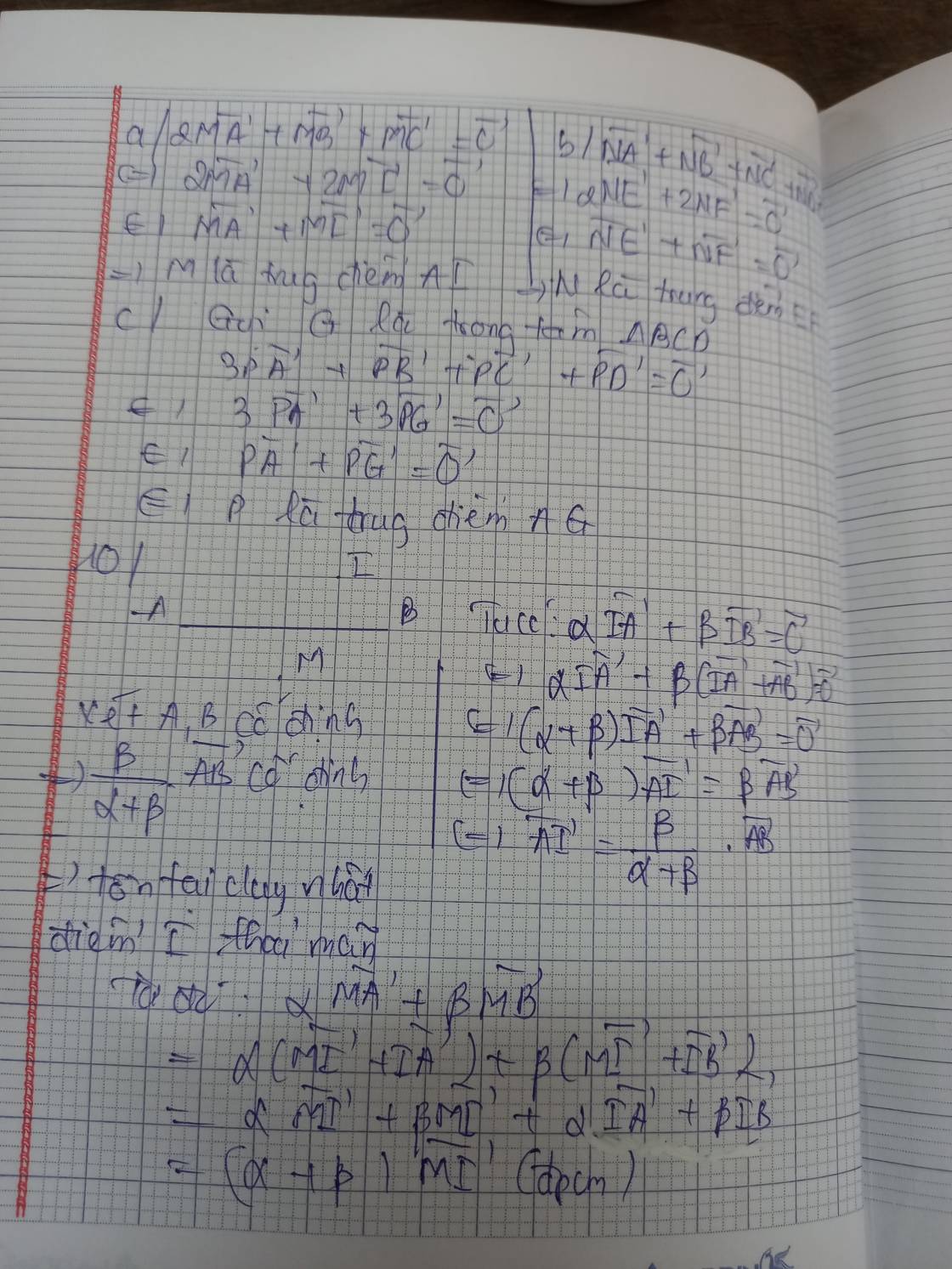Hãy nhập câu hỏi của bạn vào đây, nếu là tài khoản VIP, bạn sẽ được ưu tiên trả lời.

Thay vì \(\alpha;\beta;\gamma\) khó gõ kí tự, mình chuyển thành \(a,b,c\) cho dễ, bạn tự thay lại.
Do ABCD là hbh \(\Rightarrow\overrightarrow{AC}=\overrightarrow{AB}+\overrightarrow{AD}\)
- Chứng minh chiều thuận: I, F, K thẳng hàng \(\Rightarrow\dfrac{1}{b}=\dfrac{1}{a}+\dfrac{1}{c}\)
Do I, F, K thẳng hàng \(\Rightarrow\) tồn tại một số \(k\ne0\) để \(\overrightarrow{KF}=k.\overrightarrow{KI}\)
\(\Rightarrow\left(\overrightarrow{KA}+\overrightarrow{AF}\right)=k.\left(\overrightarrow{KA}+\overrightarrow{AI}\right)\Rightarrow\left(-c.\overrightarrow{AD}+b.\overrightarrow{AC}\right)=k\left(-c.\overrightarrow{AD}+a.\overrightarrow{AB}\right)\)
\(\Rightarrow\overrightarrow{AD}\left(ck-c\right)=k.a.\overrightarrow{AB}-b.\overrightarrow{AC}=ka.\overrightarrow{AB}-b.\overrightarrow{AB}-b.\overrightarrow{AD}\)
\(\Rightarrow\overrightarrow{AD}\left(ck-c+b\right)=\overrightarrow{AB}\left(ka-b\right)\) (1)
Do \(\overrightarrow{AD};\overrightarrow{AB}\) không cùng phương \(\Rightarrow\left(1\right)\) xảy ra khi và chỉ khi:
\(\left\{{}\begin{matrix}ck-c+b=0\\ka-b=0\end{matrix}\right.\) \(\Rightarrow\left\{{}\begin{matrix}k=\dfrac{c-b}{c}\\k=\dfrac{b}{a}\end{matrix}\right.\)
\(\Rightarrow\dfrac{c-b}{c}=\dfrac{b}{a}\Rightarrow1=\dfrac{b}{a}+\dfrac{b}{c}\Rightarrow\dfrac{1}{b}=\dfrac{1}{a}+\dfrac{1}{c}\) (đpcm)
- Chứng minh chiều nghịch: \(\dfrac{1}{b}=\dfrac{1}{a}+\dfrac{1}{c}\Rightarrow\) I, F, K thẳng hàng
\(\dfrac{1}{b}=\dfrac{1}{a}+\dfrac{1}{c}\Rightarrow b=\dfrac{ac}{a+c}\)
\(\overrightarrow{FI}=\overrightarrow{FA}+\overrightarrow{AI}=-b.\overrightarrow{AC}+a.\overrightarrow{AB}=-b\left(\overrightarrow{AB}+\overrightarrow{AD}\right)+a.\overrightarrow{AB}\)
\(\Rightarrow\overrightarrow{FI}=-\dfrac{ac}{a+c}\overrightarrow{AB}-\dfrac{ac}{a+c}\overrightarrow{AD}+a.\overrightarrow{AB}=\dfrac{a^2}{a+c}\overrightarrow{AB}-\dfrac{ac}{a+c}\overrightarrow{AD}\)
\(\Rightarrow\overrightarrow{FI}=\dfrac{a}{a+c}\left(a.\overrightarrow{AB}-c.\overrightarrow{AD}\right)\) (1)
Lại có \(\overrightarrow{KI}=\overrightarrow{KA}+\overrightarrow{AI}=-c.\overrightarrow{AD}+a.\overrightarrow{AB}=a.\overrightarrow{AB}-c.\overrightarrow{AD}\) (2)
Từ (1), (2) \(\Rightarrow\overrightarrow{FI}=\dfrac{a}{a+c}\overrightarrow{KI}\) ; mà \(\dfrac{a}{a+c}\) là hằng số \(\ne0\)
\(\Rightarrow F,I,K\) thẳng hàng (đpcm)
Vậy F, I, K thẳng hàng khi và chỉ khi \(\dfrac{1}{b}=\dfrac{1}{a}+\dfrac{1}{c}\)

\(A=tan\left(a+b\right)=tan\frac{\pi}{4}=1\)
Ta có: \(tan\left(a+b\right)=\frac{tana+tanb}{1-tana.tanb}\)
\(\Rightarrow B=tana+tanb=tan\left(a+b\right)\left(1-tana.tanb\right)=1.\left(1-3+2\sqrt{2}\right)=2\sqrt{2}-2\)
\(\left\{{}\begin{matrix}tana+tanb=2\sqrt{2}-2\\tana.tanb=3-2\sqrt{2}\end{matrix}\right.\)
Theo Viet đảo, \(tana;tanb\) là nghiệm của:
\(x^2-\left(2\sqrt{2}-2\right)x+3-2\sqrt{2}=0\)
\(\Leftrightarrow\left(x-\sqrt{2}+1\right)^2=0\Rightarrow x=\sqrt{2}-1\)
\(\Rightarrow tana=tanb=\sqrt{2}-1\Rightarrow a=b=\frac{\pi}{8}\)

\(A=cos^2a+cos^2b+2cosa.cosb+sin^2a+sin^2b+2sina.sinb\)
\(=2+2\left(cosa.cosb+sina.sinb\right)\)
\(=2+2.cos\left(a-b\right)=2+2.cos\frac{\pi}{3}=3\)
\(B=cos^2a+sin^2b+2cosa.sinb+cos^2b+sin^2a-2sina.cosb\)
\(=2-2\left(sina.cosb-cosa.sinb\right)\)
\(=2-2sin\left(a-b\right)=2-2sin\frac{\pi}{3}=2-\sqrt{3}\)

